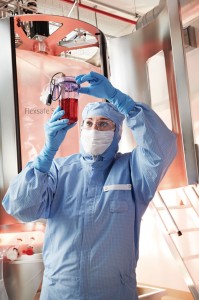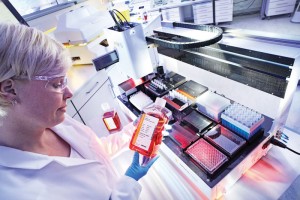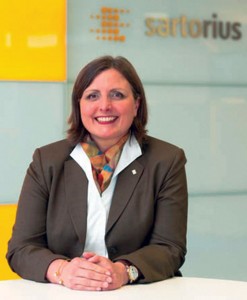
Left to right: Brian Caine (publisher of BioProcess International), Christel Fenge (vice president of marketing for fermentation technologies at Sartorius Stedim Biotech), and S. Anne Montgomery (editor in chief of BioProcess International).
Recently, BPI publisher Brian Caine and editor in chief Anne Montgomery had the opportunity to talk with Christel Fenge, Sartorius Stedim’s VP of marketing for fermentation technologies, in the Göttingen, Germany, Sartorius facility. They began by talking about fermentation technology, a topic that led them to touch upon a number of key issues in the biopharmaceutical industry.
Fermentation Technology
Caine: Because this special issue focuses on fermentation technology, let’s begin by talking about some recent technological improvements and what impact these developments will have.
Fenge: The major change or “breakthrough” of the past decade is the increasing use of single-use technologies, which started in the early 2000s with the implementation of the Wave bioreactor (now known as the BIOSTAT RM [rocking motion] bioreactor). Given the increased attrition rates and development costs, better tools were needed to make clinical trial materials more efficiently. Subsequently, single-use stirred tank bioreactors were introduced, which led to a huge improvement in the way we develop biopharmaceuticals, particularly with the large monoclonal antibody (MAb) portfolios that many big pharmas have today.
Also, process analytical technologies (PAT) have been increasingly adopted by the biopharmaceutical industry, improving development times and providing a structured approach to fully understanding the production process. Other less regulated sectors such as “white biotechnology” have adopted PAT to a much wider extent to save costs, and I believe this will happen to our industry as well. For Sartorius Stedim Biotech (SSB), this means offering design of experiments (DoE) and multivariate data analysis software tools from Umetrics, enhanced with single-use sensors for pH, oxygen and online glucose and lactate measurement. Therefore, we also decided to acquire TAP Biosystems, and we can now supply ambr multi-parallel mini-bioreactors, highly automated bioreactor systems that can significantly increase the speed and efficiency of process development.
An Acquisitions Strategy: Fenge describes the acquisition of TAP and its multi-parallel bioreactor systems as being “very deliberate.” She comments: “Our customers have a large number of development projects in their pipelines, and we wanted to be able to help them with process development. Clearly, highly automated, multi-parallel bioreactors fill a last remaining gap that hadn’t been addressed in the past. We want to make process development faster, more effective and more cost-efficient. For me, this acquisition fits perfectly. It provides full and seamless scalability from 15 mL all the way up to 2,000 L in single-use stirred tank bioreactors: from cell line development and media screening at 15 mL scale, to process characterization and scale-up at 2 L, preclinical and clinical production at 50–1000 L, and finally, full production scale at 2,000 L. The ambr bioreactor has been very quickly adopted across a number of different product segments, which demonstrates a very real industry need; if they didn’t need it, they wouldn’t have adopted it.”
Caine: Tell me about the development and maturation of your single-use bioreactors.
Fenge: We started with the Wave-style bioreactor — a simple pillow-shaped bag. Other companies were exploring the use of modified single-use mixers with noncentric mixing devices as stirred-tank bioreactors, and they launched the first single-use bioreactors (SUBs). We went one step further with the BIOSTAT STR, offering a true stirred-tank bioreactor based on the established design principles of glass and stainless steel vessels. For us, it was very important to create a bioreactor that provides the same scale-up characteristics and process performance that biotechnologists have been using for decades to make vaccines and drugs.
 Seamless Scalablity: The major benefit for the customer, Fenge comments, is that it provides seamless scalability from process development (2–10 L) to commercial production and straightforward process transfer to existing large-scale production capacities. She adds that the BIOSTAT STR compares extremely well with classic stainless steel stirred-tank bioreactors, even in demanding processes such as cell culture on microcarriers or high cell density, concentrated fed-batch processes. The company is now in the process of launching the 2,000 L BIOSTAT STR for commercial production.
Seamless Scalablity: The major benefit for the customer, Fenge comments, is that it provides seamless scalability from process development (2–10 L) to commercial production and straightforward process transfer to existing large-scale production capacities. She adds that the BIOSTAT STR compares extremely well with classic stainless steel stirred-tank bioreactors, even in demanding processes such as cell culture on microcarriers or high cell density, concentrated fed-batch processes. The company is now in the process of launching the 2,000 L BIOSTAT STR for commercial production.
Ease of Use: “A key aspect for us during development was ease of use. Installing a 1,000-L or 2,000-L single-use bioreactor bag needs to be carefully considered; users are looking for easy, fast, and straightforward procedures that avoid complicated and risky bag manipulations. With the STR, you open the door, insert the bag (with a special lifting device for the 2,000 L version), fix it at the bottom of the bag holder and at the motor drive, and off you go,” she adds.
The 2,000-L STR bioreactor is based on the same design principles as the smaller 50-L to 1,000-L versions that have been on the market since late 2008. With the development of the smaller BIOSTAT STR family, members started the interaction with customers and what functionality is required for their various processes. “Collaboration partners in the vaccine industry and the MAb space discussed aspects such as impeller and sparger design, port types and sizes, connectivity, exhaust lines and biosafety concepts with us, and what capabilities and technical solutions they are looking for. Our process scientists frequently liaise with customers to gain a deep insight into their processes and needs, which is extremely useful,” said Fenge.
Montgomery: What are your thoughts about the scalability of single-use bags: in practical terms, is 2,000 L the uppermost limit?
Fenge: Yes, we believe so for various reasons. High titers (5–10 g/L) and the trend toward smaller indications, personalized medicine, and regional production make 2,000 L a very attractive option. Another trend is the move toward concentrated fed-batch, a type of continuous culture in which the product remains in the bioreactor, and that enables very high product titers. Typically, companies want to benefit from single-use and smaller bioreactors to make their processes more manageable, make capacity adaptation more flexible, and derisk process transfers.
Film Strategy
 Caine: In connection with the 2,000-L BIOSTAT STR version, I understand you developed a new film, especially for this large-scale single-use bioreactor.
Caine: In connection with the 2,000-L BIOSTAT STR version, I understand you developed a new film, especially for this large-scale single-use bioreactor.
Fenge: During the past two years, we have been working on our “film strategy.” This is a materials science project for future single-use manufacturing. As the use of single-use bioreactors in commercial production increases, our customers are looking for new levels of assurance of supply and business continuity when it comes to components and raw materials. They are concerned about change control; namely, how we as a vendor control and manage changes in our production and supply chain. Companies are now “outsourcing” activities that, in the past, they used to control themselves. And given the single-use nature of today’s bioreactors, manufacturing them is a recurring process and not a one-off event covered by installation and operational qualification (IQ/OQ) as it was in the past when commissioning stainless steel production capacity.
As such, we are committed to understanding and controlling the whole production process and the quality requirements that go with it. One aspect is raw material traceability, right down to the polymer resins, to where the polymers are manufactured, establishing traceability and control over the entire process from the resin and the additives to the final bag. We want to ensure, for the long-term, that the film material we use in our bags is of consistent quality. We achieve this by establishing specifications and controls for the polymer resins and additives that are used to manufacture the new film and by establishing process understanding and control of the film extrusion, bag assembly, and gamma irradiation processes.
Montgomery: Can you give us some specific characteristics about your Flexsafe bags and the new polyethylene film?

From a few milliliters up to 2,000 L, Sartorius Stedim Biotech covers the complete product range of bioreactors
for upstream processing.
Fenge: The new Flexsafe STR bags were an important component in the development of the 2,000-L bioreactor and its application in commercial production. It was important for SSB to ensure the consistent supply of a dependable polymer film that would provide the robustness and assurance of supply that people look for when using the product in full-scale manufacturing.
One key driver was the sheer size of the 2,000-L bag, which forced the company to look into a new film and our desire to stick to the same geometrical design principles of the existing STR product range. We also knew that our customers had experienced poor cell growth with certain (other) bags, so we — and our industry partners — focused on that when we developed the new polyethylene (PE) film. It turned out that certain antioxidants degrade to substances that are toxic to cells, even at very low levels, so we optimized the antioxidant package to ensure that we can consistently supply single-use bioreactor bags that deliver excellent cell growth. Another key aspect is robustness; bags need to reliably work in day-to-day operations.
Our new PE film is the thickest in the industry and the most robust. We try to balance its stiffness or rigidity with flexibility. A bag has to be flexible, but also rigid enough to work in a three-dimensional large-scale bioreactor, mixer, or shipping bag. It must be resistant to both hydrostatic pressure and liquid movement, which is why we spent almost two years developing the new PE film. We wanted to put the key elements of traceability, control, assurance of supply, and robustness firmly in place. And right from the beginning, we wanted to have a PE film that works for a broad range of different bioprocessing applications, including stirred bioreactors, Wave-type bags, large mixing and shipping bags, storage and freeze-and-thaw bags, to reduce the validation effort of our customers.
Caine: How do you address customer concerns about extractables and leachables?
Fenge: We typically provide our customers with an E&L guide. Under a confidentiality agreement, they get access to model liquid (water and ethanol) data. An E&L guide is available for each bioprocessing bag type and covers the E&L analysis for the complete bag, including the film, tubing, connectors, and/or, in the case of the Flexsafe STR, the agitation and sparger system components. Customers can then decide what data to submit to the regulatory agencies, using either our model data or data for their specific process fluids. SSB can also perform process-specific E&L studies with customer liquids. With the new film, we’ve taken an even more rigorous approach; as a supplier, you cannot provide reliable E&L data if you don’t have full control of your polymer resin, additive package and film and bag manufacturing process. Only by doing so can you assess whether the E&L profile for one batch is representative of future batches. With full control, we can take the E&L discussion to a new level.
 Materials Composition and Sourcing Issues: Many companies are still rather naïve regarding how the films are made, what the sourcing issues are, and how variations in composition might affect their products. Fenge comments that “manufacturing your own film helps to provide greater customer assurance. If a company is going commercial, it will need to supply patients for years. We’re not talking about a clinical trial; we’re talking about guaranteeing the supply for full-scale, commercial production, for the long-term. Companies should talk to us about the materials science involved, about the film manufacturing process, and about the controls we have in place. As single-use technologies mature and move into commercial production, the industry is demanding assurance of supply. They want to ensure that their vendors can provide them with single-use bags that show consistent quality and reliable performance over and over again,” says Fenge, “Putting raw material specifications in place and establishing operating ranges for the extrusion process reflects the cGMPs that our customers use in their own manufacturing.
Materials Composition and Sourcing Issues: Many companies are still rather naïve regarding how the films are made, what the sourcing issues are, and how variations in composition might affect their products. Fenge comments that “manufacturing your own film helps to provide greater customer assurance. If a company is going commercial, it will need to supply patients for years. We’re not talking about a clinical trial; we’re talking about guaranteeing the supply for full-scale, commercial production, for the long-term. Companies should talk to us about the materials science involved, about the film manufacturing process, and about the controls we have in place. As single-use technologies mature and move into commercial production, the industry is demanding assurance of supply. They want to ensure that their vendors can provide them with single-use bags that show consistent quality and reliable performance over and over again,” says Fenge, “Putting raw material specifications in place and establishing operating ranges for the extrusion process reflects the cGMPs that our customers use in their own manufacturing.
“We feel it is extremely important that we, as suppliers of single-use components and solutions, fully understand what they will be used for, as well as the significant value of the pharmaceutical intermediates and products being used in them. Understanding the product profile is important: What is the intended use, what are people doing with it, what do they expect? As such, we communicate with our end users. Some companies even come to our production site to talk about their drug manufacturing processes and products; we try to establish a connection with the end users,” adds Fenge.
Standardization
Montgomery: Do you get many questions about the compatibility of your materials with those of other single-use manufacturers?
Fenge: Yes, absolutely. We currently incorporate components from various vendors. Our customers want interchangeable systems that can use both our bags and our competitors’ bags, so it’s all about standardization. And as much as we try to accommodate the needs of our customers, it makes the supply chain very challenging and involves a lot of manual work and risk assessments, which adds to the cost. In the past, this was not a major concern because most single-use bioreactors and bags were used in clinical manufacturing. And because it is a relatively young technology, there is a lot of innovation, and people want to test different solutions or simply come up with their own designs. But achieving the level of assurance and robustness of supply that’s needed for commercial production when faced with all these different components and modifications — that’s a different matter. Customers should consider this aspect very seriously as their use of single-use solutions increases, which is why we talk to our customers about standardization. It makes the supply chain easier and more robust, not just for us, but also for our customers. It helps to achieve price security, and most of all, customers can rely on tested process solutions whereas bespoke solutions might include unidentified process risks, especially for more complex single-use applications or whole unit operations such as bioreactors.
Assessing Risks in Single-Sourcing: For an end user, from a validation standpoint, it does mean releasing control, particularly if they’re using Sartorius as a single-source solution provider. “It might require a leap of faith,” admits Fenge, “and this is something that definitely needs ongoing work. But single sourcing is not new to the industry; it’s common practice for critical components such as microcarriers, chromatography gels, and virus filters. It’s really about risk assessment, balancing risks and benefits, and ultimately, risk management through (for example) the use of safety stocks, close collaborations, and quality agreements between suppliers and end users. As a supplier, we are committed to building trust in our materials strategy and quality assurance. We’ve not yet reached the end of the innovation stage in single-use and/or the level of maturity that is necessary to standardize, so there’s still quite a lot of work to be done.”
Long-term film supply and disaster preparedness is another critical consideration. But Fenge feels confident about addressing business continuity through a mix of establishing back-up raw materials for the polymer resins, back-up film extrusion and bag manufacturing capabilities, and safety stocks of resins and film rolls. “There are two elements to the new film strategy,” she says. “One element is controlling how the film is manufactured, which ensures batch-to-batch consistency; and the other is the business continuity element, which is based on long-term agreements with our extrusion and resin partners, safety stocks, and back-up capabilities.”
Media Advances

SSB’s ambr15 system enables rapid evaluation of 24 or 48 multiple bioreactor cultures at microscale.
Caine: You acquired Lonza’s cell culture media business at the end of 2012. Tell us about the role that’s going to play and how that helps you to become a total solution provider.
Fenge: One aspect that we couldn’t supply in the past was cell culture media. But given our desire to provide a “total solution,” customers can now buy liquid media from us in our bags, made with our filters. Or alternatively, they can use powder media, making their media at the point of use using our Flexact MP unit, filters, and bags. We are also developing further applications in this area based on the acquisition of the ambr multi-parallel bioreactors. Our goal is to bring added value to our customers, and so far the introduction of a media offering has gone extremely well, especially with our key accounts. Very often, they will use their own cell culture medium but might be looking for a second supplier, which provides an opportunity to discuss buying it from us. Of course, we are not well known as a cell culture media company. But Lonza has years of media (powder and liquid) development and manufacturing experience. Working together, our combined market reach, expertise, and capabilities enable us to support our customers even better.
Long-Term Growth Strategy: The media offering is part of the company’s 2020 strategy, a key component for future growth. And Fenge acknowledges that having the long-term strategy to be a total solution provider means that Sartorius has been quite aggressive in the short-term to put all the pieces of that strategic plan — the vision — together.
Expanding Capabilities
Looking ahead, Fenge expects the company’s single-use capabilities to grow and expand into other areas, such as the production of ADCs, cell therapies, biosimilars, and so on. “We’re keeping a close eye on those applications, and in fact, we’re already very active in biosimilars and the ADC field. We’ve recently engaged a Regenerative Medicine Taskforce to work specifically with that market segment and position our existing products there more strategically than we’ve done in the past. We also envision selected developments or adaptations. Regarding cell therapy, for example, I don’t think you can really do cell therapy without using closed, single-use systems. We are also working with Lonza and other collaboration partners to demonstrate good stem cell propagation. We strongly believe in the suspension route for scale-up, which doesn’t necessarily mean that you have to grow the cells in single cell suspension. But ultimately, we believe very strongly in stirred tanks. You can control them. It will be interesting to see what develops and becomes standard procedure in the years ahead.”
Bag Testing and Packaging
Montgomery: How does your new bag tester ensure process safety, and how does your new packaging concept fit into that picture?
Fenge: Beyond talking about materials science, consistency, control, and business continuity, we thought about how else Sartorius Stedim Biotech could help customers to derisk their use of single-use systems. All things considered, it’s a bag. But special considerations are necessary for the transport, storage, unpacking, and installation of that bag, so we have developed a device that allows operators to pressure test their bioreactor bag assembly, postinstallation but preuse; it’s very similar to the approach that many users take for their steel tanks. So far, we have qualified the bag tester for our CultiBag STR bags, from 50 to 1,000 L, and qualification for the new Flexsafe STR bag range (up to 2,000 L) is in progress. In addition, we are shipping our STR bags overseas to destinations such as North and Latin America, Australia, China, Korea, and India, to places where the roads are not always in the best shape. Our new packaging concept helps to ensure safe transport and mitigates any risks of damage during transportation. It has passed the very stringent ASTM shipping validation conditions.
Caine: What you think the future is going to hold for single-use technologies?
Fenge: I believe that we will see an increased level of automation and a move toward automated single-use facilities. This will reduce manual handling. Single-use sensor technologies are also improving, and so I think we will see more industrialized processing, comparable with the routine production of chemical APIs. We will see a push toward the so-called ballroom concept, which will help to address cost pressures. With robust data on the safety of closed single-use systems, we will also be able to help our customers to present the ballroom facility concept to the regulatory agencies.
Enabling Global Expansion
 Finally, Fenge describes the use of single-use technologies as an enabler that will provide the opportunity to expand drug development and manufacturing applications around the world for many types of disease treatments. “As emerging economies grow stronger, their population wants access to the kinds of medications that we are already enjoying today in our developed world. So absolutely, single-use is definitely here to stay,” she concludes.
Finally, Fenge describes the use of single-use technologies as an enabler that will provide the opportunity to expand drug development and manufacturing applications around the world for many types of disease treatments. “As emerging economies grow stronger, their population wants access to the kinds of medications that we are already enjoying today in our developed world. So absolutely, single-use is definitely here to stay,” she concludes.
Christel Fenge is Sartorius Stedim Biotech’s VP of marketing for fermentation technologies, based in Göttingen, Germany. Brian Caine is cofounder and publisher, and S. Anne Montgomery is cofounder and editor in chief of BioProcess International, amontgomery@ bioprocessintl.com.
